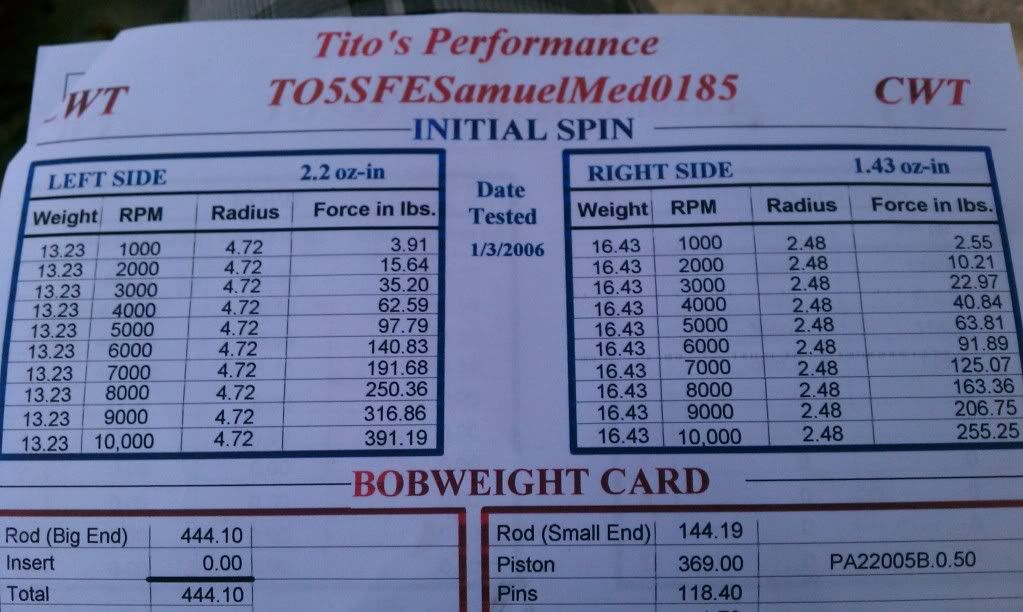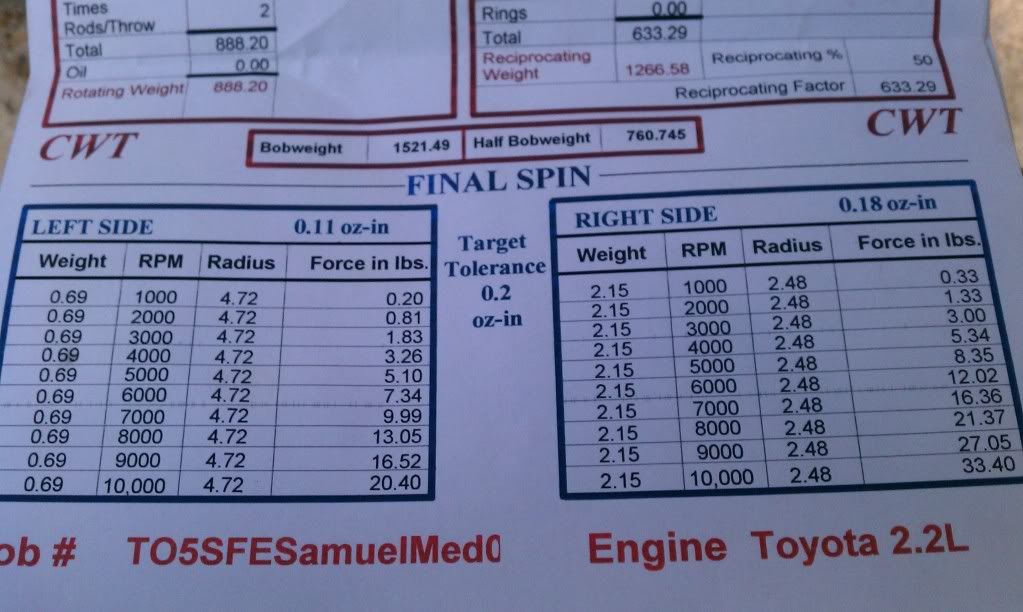 Jun 17, 2013 - 12:15 AM Jun 17, 2013 - 12:15 AM
|
|
 Enthusiast      Joined Jan 4, '12 From US Currently Offline Reputation: 6 (100%) |
If you're thinking about building your engine to work past the stock limits, you might want to take into consideration balancing the rotating assembly at a good, reputable place, preferably specialized in balancing engines.
First, the tables of my rotating assembly (before and after balancing). Important information on what I brought to the shop: 1. 98+ Camry crankshaft with the gear for the balance shaft still installed. 2. Crankshaft was only polished, not ground down for undersized bearings nor 3SGTE rods, and it hadn't been previously balanced aside from the (crappy) factory balance. 3. OEM like-new flywheel (seems to have been replaced by PO, so it's likely it's not a Toyota flywheel, but it's not a lightweight replacement either) 4. XTD "heavy-duty" pressure plate 5. OEM flywheel bolts 6. 98+ Camry timing gear with crank sensor trigger wheel and its washer 7. My OEM harmonic balancer/accessory pulley With that said, here are the pictures:   The engine came balanced from the factory to what it seems +/- 2 grams of tolerance. 2 grams, not a fraction of a gram. This is very bad for a performance engine, but OK for a daily use engine. Here's an explanation as to why I say this based on my limited knowledge on the topic and the explanation given to me by the engine builder who balanced my rotating assembly. Note the first table of the first picture: on there you'll see that 2.2oz-in will cause 35.20 lbs of force on the bearings at 3000 RPM. That's OK and not that much for that RPM. It won't kill your engine and it'll last for pretty long seeing that kind of strain. However notice the strain it's susceptible to at 7000RPM: 198.62lbs; that's a lot. As you go higher even, you'll see more and more. On the right side table it's the same story. After balancing, nearly the same ~30lbs are seen by the bearings at 10,000RPM instead of the previous 3,000RPM. It's pretty easy to see how important engine balance is. It'll help your bearings last a lot longer, as well as your engine. -------------------- 1993 Celica GT Coupe - sold
1994 Celica GT Liftback |
 |
Replies
 Jul 26, 2013 - 3:25 PM Jul 26, 2013 - 3:25 PM
|
|
|
Enthusiast   Joined Aug 29, '08 From Auckland, New Zealand Currently Offline Reputation: 0 (0%) |
Surely would you see performance gains by balancing the assembly? Or is it mainly a durability thing.
|
Posts in this topic
 Syaoran Engine Balance Jun 17, 2013 - 12:15 AM
Syaoran Engine Balance Jun 17, 2013 - 12:15 AM
 Box Being these engine last well over 200,000 miles as... Jun 17, 2013 - 1:44 AM
Box Being these engine last well over 200,000 miles as... Jun 17, 2013 - 1:44 AM
 Syaoran Yeah, but there is a reason as to why I posted thi... Jun 17, 2013 - 4:10 PM
Syaoran Yeah, but there is a reason as to why I posted thi... Jun 17, 2013 - 4:10 PM

 Syaoran QUOTE (PolliS_5S-FE @ Jul 26, 2013 ... Jul 28, 2013 - 1:03 AM
Syaoran QUOTE (PolliS_5S-FE @ Jul 26, 2013 ... Jul 28, 2013 - 1:03 AM
 Box In theory it would free up some power by reducing ... Jul 28, 2013 - 1:10 AM
Box In theory it would free up some power by reducing ... Jul 28, 2013 - 1:10 AM
 delusionz A few questions
1. When doing a cambelt job later... Jul 29, 2013 - 4:37 PM
delusionz A few questions
1. When doing a cambelt job later... Jul 29, 2013 - 4:37 PM

 Syaoran QUOTE (delusionz @ Jul 29, 2013 - 5... Jul 29, 2013 - 5:43 PM
Syaoran QUOTE (delusionz @ Jul 29, 2013 - 5... Jul 29, 2013 - 5:43 PM
 delusionz i have little markings on everything, including my... Jul 29, 2013 - 6:31 PM
delusionz i have little markings on everything, including my... Jul 29, 2013 - 6:31 PM

 Syaoran QUOTE (delusionz @ Jul 29, 2013 - 7... Jul 30, 2013 - 11:02 AM
Syaoran QUOTE (delusionz @ Jul 29, 2013 - 7... Jul 30, 2013 - 11:02 AM
 H8TRAIN Really appreciate the data in the pics Syaoran... Nov 10, 2013 - 1:03 PM
H8TRAIN Really appreciate the data in the pics Syaoran... Nov 10, 2013 - 1:03 PM  |
2 User(s) are reading this topic (2 Guests and 0 Anonymous Users)
0 Members:
| Lo-Fi Version | Time is now: November 29th, 2024 - 6:41 AM |



